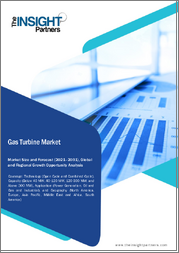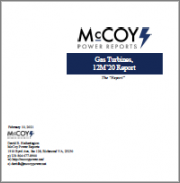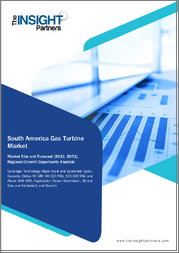
|
시장보고서
상품코드
1462706
산업용 가스 터빈 점화 시스템 시장 전망(-2030년) : 제품 유형별, 연료 유형별, 구성품별, 가스 터빈 유형별, 용도별, 최종 사용자별, 지역별 세계 시장 분석Industrial Gas Turbine Ignition System Market Forecasts to 2030 - Global Analysis By Product Type, Fuel Type, Component, Gas Turbine Type, Application, End User and By Geography |
||||||
Stratistics MRC에 따르면 산업용 가스 터빈 점화 시스템 세계 시장은 2023년 14억 6,000만 달러로 평가되었고, 예측 기간 동안 CAGR 11.0%로 성장하여 2030년에는 30억 3,000만 달러에 달할 것으로 예상됩니다.
산업용 가스 터빈 점화 시스템은 발전 또는 기계 구동 응용 분야에 사용되는 가스 터빈의 연소를 시작합니다. 일반적으로 연소실에 전략적으로 배치된 점화 플러그 또는 점화 장치와 관련 제어 시스템으로 구성됩니다. 신호를 받으면 시스템은 고전압 방전을 공급하여 연료와 공기 혼합물에 점화를 일으켜 터빈의 연속 작동을 촉진합니다. 최신 시스템은 종종 첨단 센서와 알고리즘을 통합하여 점화 타이밍을 최적화하고 효율성을 높이며 안전하고 신뢰할 수 있는 시동을 보장합니다. 효과적인 점화는 터빈의 성능, 배출가스 최소화, 에너지 출력 극대화, 다양한 산업 환경에서의 운전 안정성 유지에 매우 중요합니다.
국제에너지기구(IEA)에 따르면 2018년 세계 전력 투자의 약 45%는 중국, 동남아시아, 중남미 대부분을 포함한 중상위권 국가에서 이루어졌습니다.
가스 화력 발전소 증가
더 많은 가스 화력 발전소가 건설되거나 확장됨에 따라 점화 시스템을 포함한 산업용 가스 터빈 및 관련 부품에 대한 수요가 증가할 것으로 예상됩니다. 가스 터빈은 가스 화력 발전소에서 발전하는 데 사용되는 주요 기술이며, 이러한 터빈을 시동하고 제어하기 위한 점화 시스템에 대한 수요를 주도하고 있습니다. 또한, 더 많은 발전소가 가동되거나 업그레이드됨에 따라 점화 시스템 공급업체가 시장 입지를 확대하고 업계에서 더 큰 점유율을 차지할 수 있는 기회가 생길 것으로 보입니다.
높은 설치 초기 비용
산업용 가스 터빈 점화 시스템 설치에는 초기 비용이 많이 들기 때문에 중소기업과 신규 진출기업에게는 시장 진입 장벽이 될 수 있습니다. 경영 자원이 한정된 기업은 R&D 및 생산 규모 확대에 투자하는 데 어려움을 겪을 수 있으며, 이는 경쟁과 혁신을 제한할 수 있습니다. 그 결과, 이러한 시스템의 채택률이 낮아지고, 보다 효율적이고 신뢰할 수 있는 점화 기술로의 전환이 지연되어 시장 성장을 저해할 수 있습니다.
더 깨끗하고 효율적인 산업용 가스 터빈 점화 시스템의 필요성
산업계가 배기가스 배출을 줄이고 에너지 효율을 개선하기 위해 노력함에 따라 더 깨끗하고 효율적인 산업용 가스 터빈 점화 시스템에 대한 수요가 증가하고 있으며, 더 깨끗하고 효율적인 점화 시스템에 대한 관심은 시장의 기술 혁신을 촉진할 것입니다. 이러한 수요는 기업이 기존 시스템을 첨단 점화 기술로 업그레이드하거나 교체하여 연소 효율을 개선하고 전체 터빈의 성능을 향상시키기 위해 투자함으로써 시장 성장을 가속할 것입니다.
대체 에너지원의 활용성
대체 에너지의 용이성태양광, 풍력, 수력 등 대체 에너지원이 더 쉽게 이용할 수 있고 비용 효율성이 높아지면 가스 화력 발전과 경쟁할 수 있게 되어 산업용 가스 터빈 점화 시스템에 대한 수요가 감소할 것입니다. 산업계와 전력 회사는 기존 가스 화력 발전보다 재생 가능 에너지 발전 프로젝트에 대한 투자를 우선시하여 가스 터빈 점화 시스템의 개발 및 채택에서 자원을 전환 할 수 있습니다. 이는 가스 터빈 점화 시스템 공급업체 시장 점유율과 수익 감소로 이어질 수 있습니다.
COVID-19의 영향
폐쇄 조치와 경제의 불확실성으로 인해 투자 결정이 연기되어 터빈의 신규 건설 및 유지보수 활동에 영향을 미쳤습니다. 그러나 이 위기는 또한 운영 효율성과 복원력에 대한 관심을 높이고 터빈의 성능을 최적화하고 가동 중단 시간을 줄이는 혁신적인 점화 시스템에 대한 수요를 촉진했습니다. 원격 모니터링 및 예지보전 솔루션은 이동이 제한된 상황에서 운영의 연속성을 보장하기 위해 주목받게 되었습니다. 복구 노력이 계속되는 가운데 지속가능성과 디지털화에 대한 강조가 향후 추세를 형성하고 시장은 점차 회복될 것으로 예상됩니다.
예측 기간 동안 글로우 플러그 점화 시스템 분야가 가장 큰 시장으로 성장할 것으로 예상됩니다.
그로우 플러그 점화 시스템은 콜드 스타트 성능 향상, 배기가스 배출 감소, 연비 향상 등의 이점을 제공하기 때문에 글로우 플러그 점화 시스템 분야가 성장할 것으로 예상됩니다. 그러나 대규모 산업용 터빈에 적용하기 위해서는 확장성, 내구성, 기존 인프라와의 호환성 등의 과제가 남아있습니다. 이러한 문제에도 불구하고, 글로우 플러그 기술의 도입은 시장의 혁신과 경쟁을 촉진하고, 보다 효율적이고 친환경적인 터빈 운전에 대한 고객의 진화하는 요구에 부응하기 위해 제조업체들이 첨단 점화 솔루션을 개발할 수 있는 원동력이 될 수 있습니다.
예측 기간 동안 대형 가스 터빈 분야가 가장 높은 CAGR을 나타낼 것으로 예상됩니다.
대형 가스 터빈 분야는 예측 기간 동안 가장 높은 CAGR 성장을 보일 것으로 예상됩니다. 대형 터빈은 일반적으로 효율적인 연소 및 발전을 보장하기 위해 견고하고 신뢰할 수 있는 점화 시스템을 필요로 합니다. 이러한 수요로 인해 제조업체는 더 높은 점화 에너지와 가혹한 작동 조건에서의 내구성과 같은 중장비 응용 분야의 특정 요구 사항에 맞는 고급 점화 기술의 혁신과 개발을 추진할 수 있습니다. 또한, 대형 가스 터빈의 설치 확대는 점화 시스템 공급업체들이 새로운 시장에 진입하여 산업용 가스 터빈 부문에서 입지를 다질 수 있는 기회를 제공할 수 있습니다.
가장 큰 점유율을 차지하는 지역
아시아태평양은 특히 중국, 인도, 일본, 한국과 같은 국가의 급속한 산업화로 인해 예측 기간 동안 가장 큰 시장 점유율을 차지할 것으로 예상됩니다. 이는 발전 수요 증가로 이어져 산업용 가스 터빈 및 점화 시스템을 포함한 구성 요소에 대한 수요를 주도하고 있습니다. 또한, 산업용 가스 터빈은 제조업, 석유 및 가스, 유틸리티와 같은 산업에서 중요한 발전원이 되고 있습니다. 따라서 이러한 터빈용 점화 시스템 시장은 성장할 가능성이 높습니다.
CAGR이 가장 높은 지역 :
북미의 강화된 환경 규제로 인해 산업계는 가스 터빈을 포함한 더 깨끗하고 효율적인 기술을 도입해야 하며, 북미가 예측 기간 동안 가장 높은 CAGR을 보일 것으로 예상됩니다. 점화 시스템은 효율적인 연소 및 배기가스 배출 감소에 중요한 역할을 합니다. 기업들은 규제 요건을 충족하기 위해 첨단 점화 시스템에 투자하고 있습니다. 또한, 재생 가능 에너지 원과 가스 터빈 발전소의 통합은 원활한 운영과 전력망 안정성을 위해 고급 점화 시스템이 필요하며, 이는 시장 성장을 가속하고 있습니다.
무료 커스터마이징 서비스
이 보고서를 구독하는 고객은 다음과 같은 무료 맞춤화 옵션 중 하나를 사용할 수 있습니다.
- 기업 프로파일
- 추가 시장 기업의 종합적인 프로파일링(최대 3개사까지)
- 주요 기업의 SWOT 분석(최대 3개사)
- 지역 세분화
- 고객의 관심에 따른 주요 국가별 시장 추정치, 예측, CAGR(주: 타당성 확인에 따라 다름)
- 경쟁사 벤치마킹
- 제품 포트폴리오, 지리적 입지, 전략적 제휴를 기반으로 한 주요 기업 벤치마킹
목차
제1장 주요 요약
제2장 서문
- 개요
- 이해관계자
- 조사 범위
- 조사 방법
- 데이터 마이닝
- 데이터 분석
- 데이터 검증
- 조사 접근
- 조사 소스
제3장 시장 동향 분석
- 성장 촉진요인
- 성장 억제요인
- 기회
- 위협
- 제품 분석
- 용도 분석
- 최종사용자 분석
- 신흥 시장
- COVID-19의 영향
제4장 Porter의 Five Forces 분석
- 공급 기업의 교섭력
- 바이어의 교섭력
- 대체품의 위협
- 신규 진출업체의 위협
- 경쟁 기업간 경쟁 관계
제5장 세계의 산업용 가스 터빈 점화 시스템 시장 : 제품 유형
- Glow Plug Ignition Systems
- Spark Ignition Systems
- Pilot Flame Ignition Systems
- Hot Surface Ignition Systems
제6장 세계의 산업용 가스 터빈 점화 시스템 시장 : 연료 유형별
- 디젤
- 천연가스
- 중질 연료유(HFO)
- 항공 연료
- 기타 연료 유형
제7장 세계의 산업용 가스 터빈 점화 시스템 시장 : 컴포넌트별
- Igniter
- Exciter
- Spark Plugs
- High Voltage Transformers
- Ignition Control Units
- 기타 컴포넌트
제8장 세계의 산업용 가스 터빈 점화 시스템 시장 : 가스 터빈 유형별
- 대형 가스 터빈
- 경량 가스 터빈
제9장 세계의 산업용 가스 터빈 점화 시스템 시장 : 용도별
- 화학 처리 플랜트
- 제지 공장
- 제철소
- 시멘트 공장
- 식품 가공
- 정유소
- 기타 용도
제10장 세계의 산업용 가스 터빈 점화 시스템 시장 : 최종사용자별
- 산업
- 해양
- 항공
- 광업
- 발전
- 기타 최종사용자
제11장 세계의 산업용 가스 터빈 점화 시스템 시장 : 지역별
- 북미
- 미국
- 캐나다
- 멕시코
- 유럽
- 독일
- 영국
- 이탈리아
- 프랑스
- 스페인
- 기타 유럽
- 아시아태평양
- 일본
- 중국
- 인도
- 호주
- 뉴질랜드
- 한국
- 기타 아시아태평양
- 남미
- 아르헨티나
- 브라질
- 칠레
- 기타 남미
- 중동 및 아프리카
- 사우디아라비아
- 아랍에미리트(UAE)
- 카타르
- 남아프리카공화국
- 기타 중동 및 아프리카
제12장 주요 발전
- 계약/파트너십/협업/합작투자(JV)
- 인수와 합병
- 신제품 발매
- 사업 확대
- 기타 주요 전략
제13장 기업 프로파일링
- Altronic, LLC
- Ametek, Inc.
- Ansaldo Energia S.p.A.
- Champion Aerospace LLC
- ESAB Corporation
- Hatraco Technische
- Honeywell International Inc.
- Kawasaki Heavy Industries, Ltd
- Knite
- Koch Industries, Inc
- Meggitt PLC
- Mitsubishi Heavy Industries Ltd
- NGK Spark Plug Co., Ltd.
- Siemens Energy AG
- Stanley Engineered Fastening
- Unison
- Unison Industries, LLC
- Woodward
LSH 24.05.10
According to Stratistics MRC, the Global Industrial Gas Turbine Ignition System Market is accounted for $1.46 billion in 2023 and is expected to reach $3.03 billion by 2030 growing at a CAGR of 11.0% during the forecast period. An industrial gas turbine ignition system initiates combustion in gas turbines used for power generation or mechanical drive applications. It typically comprises spark plugs or igniters strategically positioned within the combustion chamber, along with associated control systems. Upon receiving a signal, the system delivers high-voltage electrical discharges to ignite the fuel-air mixture, facilitating continuous turbine operation. Modern systems often integrate advanced sensors and algorithms to optimize ignition timing, enhance efficiency, and ensure safe and reliable startup. Effective ignition is crucial for turbine performance, minimizing emissions, maximizing energy output, and maintaining operational stability in diverse industrial settings.
According to International Energy Agency (IEA), in the year 2018, nearly 45% of global power investment was made in upper-middle-income a country which includes China and much of Southeast Asia and Latin America.
Market Dynamics:
Driver:
Increasing deployment of gas-fired power plants
As more gas-fired power plants are built or expanded, there will be a higher demand for industrial gas turbines and their associated components, including ignition systems. Gas turbines are the primary technology used in gas-fired power plants for electricity generation, driving demand for ignition systems to start and control these turbines. Moreover, as more power plants come online or undergo upgrades, there will be opportunities for suppliers of ignition systems to expand their market presence and capture a larger share of the industry.
Restraint:
High initial cost of installation
The high upfront cost of installing industrial gas turbine ignition systems can act as a barrier to entry for smaller players or new entrants into the market. This may limit competition and innovation, as companies with limited resources may struggle to invest in research and development or scale up production. This can lead to a slower adoption rate of these systems, delaying the transition to more efficient and reliable ignition technologies hampering the growth of the market.
Opportunity:
Need for cleaner and more efficient industrial gas turbine ignition systems
As industries seek to reduce emissions and improve energy efficiency, there will be a growing demand for cleaner and more efficient industrial gas turbine ignition systems and the focus on cleaner and more efficient ignition systems will stimulate innovation in the market. This demand will drive market growth as companies invest in upgrading or replacing existing systems with advanced ignition technologies and improve combustion efficiency, and enhance overall turbine performance encouraging the growth of the market.
Threat:
Accessibility of alternative energy sources
As alternative energy sources such as solar, wind, and hydroelectric power become more accessible and cost-effective, they can compete with gas-fired power generation, reducing the demand for industrial gas turbine ignition systems. Industries and utilities may prioritize investment in renewable energy projects over traditional gas-fired power generation, diverting resources away from the development and adoption of gas turbine ignition systems. This can lead to decreased market share and revenue for suppliers of gas turbine ignition systems.
Covid-19 Impact
Lockdown measures and economic uncertainty led to postponement of investment decisions, affecting new turbine installations and maintenance activities. However, the crisis also prompted increased focus on operational efficiency and resilience, driving demand for innovative ignition systems to optimize turbine performance and reduce downtime. Remote monitoring and predictive maintenance solutions gained prominence to ensure continuity of operations amidst travel restrictions. As recovery efforts continue, the market is expected to rebound gradually, with emphasis on sustainability and digitalization shaping future trends.
The glow plug ignition systems segment is expected to be the largest during the forecast period
The glow plug ignition systems segment is estimated to have a lucrative growth, because glow plug systems offer advantages such as improved cold-start performance, reduced emissions, and enhanced fuel efficiency. However, their application in large-scale industrial turbines may face challenges related to scalability, durability, and compatibility with existing infrastructure. Despite these challenges, the introduction of glow plug technology could spur innovation and competition in the market, driving manufacturers to develop advanced ignition solutions to meet evolving customer demands for more efficient and environmentally friendly turbine operations.
The heavy-duty gas turbine segment is expected to have the highest CAGR during the forecast period
The heavy-duty gas turbine segment is anticipated to witness the highest CAGR growth during the forecast period; heavy-duty turbines typically require robust and reliable ignition systems to ensure efficient combustion and power generation. This demand may drive manufacturers to innovate and develop advanced ignition technologies tailored to the specific requirements of heavy-duty applications, such as higher ignition energy and durability under extreme operating conditions. Additionally, the expansion of heavy-duty gas turbine installations may create opportunities for ignition system suppliers to penetrate new markets and strengthen their foothold in the industrial gas turbine sector.
Region with largest share:
Asia Pacific is projected to hold the largest market share during the forecast period owing to the rapid industrialization, especially in countries like China, India, Japan, and South Korea. This has led to an increased demand for power generation, which in turn drives the demand for industrial gas turbines and their components, including ignition systems. Moreover, industrial gas turbines are a significant source of power generation in industries such as manufacturing, oil & gas, and utilities. Consequently, the market for ignition systems for these turbines is likely to see growth.
Region with highest CAGR:
North America is projected to have the highest CAGR over the forecast period, owing to the stricter environmental regulations in North America have prompted industries to adopt cleaner and more efficient technologies, including gas turbines. Ignition systems play a crucial role in ensuring efficient combustion and reducing emissions. Companies invest in advanced ignition systems to comply with regulatory requirements. Additionally the integration of renewable energy sources with gas turbine power plants requires sophisticated ignition systems for seamless operation and grid stability propels the growth of the market.
Key players in the market
Some of the key players in the Industrial Gas Turbine Ignition System Market include Altronic, LLC, Ametek, Inc., Ansaldo Energia S.p.A., Champion Aerospace LLC, ESAB Corporation, Hatraco Technische, Honeywell International Inc., Kawasaki Heavy Industries, Ltd, Knite, Koch Industries, Inc, Meggitt PLC, Mitsubishi Heavy Industries Ltd, NGK Spark Plug Co., Ltd., Siemens Energy AG, Stanley Engineered Fastening, Unison, Unison Industries, LLC, and Woodward
Key Developments:
In February 2024, Honeywell And Hawks Partner To Help Improve Building Sustainability Efforts At State Farm Arena. As part of this multi-year deal, Honeywell will implement a series of high-tech upgrades to State Farm Arena's building operations systems.
In December 2023, AMETEK, Inc announced that it has completed its acquisition of Paragon Medical, a leading provider of highly engineered medical components and instruments, from affiliates of American Securities LLC, in an all-cash transaction valued at approximately $1.9 billion.
In January 2023, Spartan Controls And Altronic LLC Announce New Partnership. This new partnership will enable our customers to meet and exceed reliability, uptime, and emissions targets related to natural gas engines and gas production.
Product Types Covered:
- Glow Plug Ignition Systems
- Spark Ignition Systems
- Pilot Flame Ignition Systems
- Hot Surface Ignition Systems
Fuel Types Covered:
- Diesel
- Natural Gas
- Heavy Fuel Oil (HFO)
- Aviation Fuel
- Other Fuel Types
Components Covered:
- Igniter
- Exciter
- Spark Plugs
- High Voltage Transformers
- Ignition Control Units
- Other Components
Gas Turbine Types Covered:
- Heavy-duty Gas Turbine
- Light-duty Gas Turbine
Applications Covered:
- Chemical Processing Plants
- Paper Mills
- Steel Mills
- Cement Plants
- Food Processing
- Oil Refineries
- Other Applications
End Users Covered:
- Industrial
- Marine
- Aviation
- Mining
- Power Generation
- Other End Users
Regions Covered:
- North America
- US
- Canada
- Mexico
- Europe
- Germany
- UK
- Italy
- France
- Spain
- Rest of Europe
- Asia Pacific
- Japan
- China
- India
- Australia
- New Zealand
- South Korea
- Rest of Asia Pacific
- South America
- Argentina
- Brazil
- Chile
- Rest of South America
- Middle East & Africa
- Saudi Arabia
- UAE
- Qatar
- South Africa
- Rest of Middle East & Africa
What our report offers:
- Market share assessments for the regional and country-level segments
- Strategic recommendations for the new entrants
- Covers Market data for the years 2021, 2022, 2023, 2026, and 2030
- Market Trends (Drivers, Constraints, Opportunities, Threats, Challenges, Investment Opportunities, and recommendations)
- Strategic recommendations in key business segments based on the market estimations
- Competitive landscaping mapping the key common trends
- Company profiling with detailed strategies, financials, and recent developments
- Supply chain trends mapping the latest technological advancements
Free Customization Offerings:
All the customers of this report will be entitled to receive one of the following free customization options:
- Company Profiling
- Comprehensive profiling of additional market players (up to 3)
- SWOT Analysis of key players (up to 3)
- Regional Segmentation
- Market estimations, Forecasts and CAGR of any prominent country as per the client's interest (Note: Depends on feasibility check)
- Competitive Benchmarking
- Benchmarking of key players based on product portfolio, geographical presence, and strategic alliances
Table of Contents
1 Executive Summary
2 Preface
- 2.1 Abstract
- 2.2 Stake Holders
- 2.3 Research Scope
- 2.4 Research Methodology
- 2.4.1 Data Mining
- 2.4.2 Data Analysis
- 2.4.3 Data Validation
- 2.4.4 Research Approach
- 2.5 Research Sources
- 2.5.1 Primary Research Sources
- 2.5.2 Secondary Research Sources
- 2.5.3 Assumptions
3 Market Trend Analysis
- 3.1 Introduction
- 3.2 Drivers
- 3.3 Restraints
- 3.4 Opportunities
- 3.5 Threats
- 3.6 Product Analysis
- 3.7 Application Analysis
- 3.8 End User Analysis
- 3.9 Emerging Markets
- 3.10 Impact of Covid-19
4 Porters Five Force Analysis
- 4.1 Bargaining power of suppliers
- 4.2 Bargaining power of buyers
- 4.3 Threat of substitutes
- 4.4 Threat of new entrants
- 4.5 Competitive rivalry
5 Global Industrial Gas Turbine Ignition System Market, By Product Type
- 5.1 Introduction
- 5.2 Glow Plug Ignition Systems
- 5.3 Spark Ignition Systems
- 5.4 Pilot Flame Ignition Systems
- 5.5 Hot Surface Ignition Systems
6 Global Industrial Gas Turbine Ignition System Market, By Fuel Type
- 6.1 Introduction
- 6.2 Diesel
- 6.3 Natural Gas
- 6.4 Heavy Fuel Oil (HFO)
- 6.5 Aviation Fuel
- 6.6 Other Fuel Types
7 Global Industrial Gas Turbine Ignition System Market, By Component
- 7.1 Introduction
- 7.2 Igniter
- 7.3 Exciter
- 7.4 Spark Plugs
- 7.5 High Voltage Transformers
- 7.6 Ignition Control Units
- 7.7 Other Component
8 Global Industrial Gas Turbine Ignition System Market, By Gas Turbine Type
- 8.1 Introduction
- 8.2 Heavy-duty Gas Turbine
- 8.3 Light-duty Gas Turbine
9 Global Industrial Gas Turbine Ignition System Market, By Application
- 9.1 Introduction
- 9.2 Chemical Processing Plants
- 9.3 Paper Mills
- 9.4 Steel Mills
- 9.5 Cement Plants
- 9.6 Food Processing
- 9.7 Oil Refineries
- 9.8 Other Applications
10 Global Industrial Gas Turbine Ignition System Market, By End User
- 10.1 Introduction
- 10.2 Industrial
- 10.3 Marine
- 10.4 Aviation
- 10.5 Mining
- 10.6 Power Generation
- 10.7 Other End Users
11 Global Industrial Gas Turbine Ignition System Market, By Geography
- 11.1 Introduction
- 11.2 North America
- 11.2.1 US
- 11.2.2 Canada
- 11.2.3 Mexico
- 11.3 Europe
- 11.3.1 Germany
- 11.3.2 UK
- 11.3.3 Italy
- 11.3.4 France
- 11.3.5 Spain
- 11.3.6 Rest of Europe
- 11.4 Asia Pacific
- 11.4.1 Japan
- 11.4.2 China
- 11.4.3 India
- 11.4.4 Australia
- 11.4.5 New Zealand
- 11.4.6 South Korea
- 11.4.7 Rest of Asia Pacific
- 11.5 South America
- 11.5.1 Argentina
- 11.5.2 Brazil
- 11.5.3 Chile
- 11.5.4 Rest of South America
- 11.6 Middle East & Africa
- 11.6.1 Saudi Arabia
- 11.6.2 UAE
- 11.6.3 Qatar
- 11.6.4 South Africa
- 11.6.5 Rest of Middle East & Africa
12 Key Developments
- 12.1 Agreements, Partnerships, Collaborations and Joint Ventures
- 12.2 Acquisitions & Mergers
- 12.3 New Product Launch
- 12.4 Expansions
- 12.5 Other Key Strategies
13 Company Profiling
- 13.1 Altronic, LLC
- 13.2 Ametek, Inc.
- 13.3 Ansaldo Energia S.p.A.
- 13.4 Champion Aerospace LLC
- 13.5 ESAB Corporation
- 13.6 Hatraco Technische
- 13.7 Honeywell International Inc.
- 13.8 Kawasaki Heavy Industries, Ltd
- 13.9 Knite
- 13.10 Koch Industries, Inc
- 13.11 Meggitt PLC
- 13.12 Mitsubishi Heavy Industries Ltd
- 13.13 NGK Spark Plug Co., Ltd.
- 13.14 Siemens Energy AG
- 13.15 Stanley Engineered Fastening
- 13.16 Unison
- 13.17 Unison Industries, LLC
- 13.18 Woodward
- 추가 시장 기업의 종합적인 프로파일링(최대 3개사까지)
- 주요 기업의 SWOT 분석(최대 3개사)
- 고객의 관심에 따른 주요 국가별 시장 추정치, 예측, CAGR(주: 타당성 확인에 따라 다름)
- 제품 포트폴리오, 지리적 입지, 전략적 제휴를 기반으로 한 주요 기업 벤치마킹
- 데이터 마이닝
- 데이터 분석
- 데이터 검증
- 조사 접근
- 미국
- 캐나다
- 멕시코
- 독일
- 영국
- 이탈리아
- 프랑스
- 스페인
- 기타 유럽
- 일본
- 중국
- 인도
- 호주
- 뉴질랜드
- 한국
- 기타 아시아태평양
- 아르헨티나
- 브라질
- 칠레
- 기타 남미
- 사우디아라비아
- 아랍에미리트(UAE)
- 카타르
- 남아프리카공화국
- 기타 중동 및 아프리카
According to Stratistics MRC, the Global Industrial Gas Turbine Ignition System Market is accounted for $1.46 billion in 2023 and is expected to reach $3.03 billion by 2030 growing at a CAGR of 11.0% during the forecast period. An industrial gas turbine ignition system initiates combustion in gas turbines used for power generation or mechanical drive applications. It typically comprises spark plugs or igniters strategically positioned within the combustion chamber, along with associated control systems. Upon receiving a signal, the system delivers high-voltage electrical discharges to ignite the fuel-air mixture, facilitating continuous turbine operation. Modern systems often integrate advanced sensors and algorithms to optimize ignition timing, enhance efficiency, and ensure safe and reliable startup. Effective ignition is crucial for turbine performance, minimizing emissions, maximizing energy output, and maintaining operational stability in diverse industrial settings.
According to International Energy Agency (IEA), in the year 2018, nearly 45% of global power investment was made in upper-middle-income a country which includes China and much of Southeast Asia and Latin America.
Market Dynamics:
Driver:
Increasing deployment of gas-fired power plants
As more gas-fired power plants are built or expanded, there will be a higher demand for industrial gas turbines and their associated components, including ignition systems. Gas turbines are the primary technology used in gas-fired power plants for electricity generation, driving demand for ignition systems to start and control these turbines. Moreover, as more power plants come online or undergo upgrades, there will be opportunities for suppliers of ignition systems to expand their market presence and capture a larger share of the industry.
Restraint:
High initial cost of installation
The high upfront cost of installing industrial gas turbine ignition systems can act as a barrier to entry for smaller players or new entrants into the market. This may limit competition and innovation, as companies with limited resources may struggle to invest in research and development or scale up production. This can lead to a slower adoption rate of these systems, delaying the transition to more efficient and reliable ignition technologies hampering the growth of the market.
Opportunity:
Need for cleaner and more efficient industrial gas turbine ignition systems
As industries seek to reduce emissions and improve energy efficiency, there will be a growing demand for cleaner and more efficient industrial gas turbine ignition systems and the focus on cleaner and more efficient ignition systems will stimulate innovation in the market. This demand will drive market growth as companies invest in upgrading or replacing existing systems with advanced ignition technologies and improve combustion efficiency, and enhance overall turbine performance encouraging the growth of the market.
Threat:
Accessibility of alternative energy sources
As alternative energy sources such as solar, wind, and hydroelectric power become more accessible and cost-effective, they can compete with gas-fired power generation, reducing the demand for industrial gas turbine ignition systems. Industries and utilities may prioritize investment in renewable energy projects over traditional gas-fired power generation, diverting resources away from the development and adoption of gas turbine ignition systems. This can lead to decreased market share and revenue for suppliers of gas turbine ignition systems.
Covid-19 Impact
Lockdown measures and economic uncertainty led to postponement of investment decisions, affecting new turbine installations and maintenance activities. However, the crisis also prompted increased focus on operational efficiency and resilience, driving demand for innovative ignition systems to optimize turbine performance and reduce downtime. Remote monitoring and predictive maintenance solutions gained prominence to ensure continuity of operations amidst travel restrictions. As recovery efforts continue, the market is expected to rebound gradually, with emphasis on sustainability and digitalization shaping future trends.
The glow plug ignition systems segment is expected to be the largest during the forecast period
The glow plug ignition systems segment is estimated to have a lucrative growth, because glow plug systems offer advantages such as improved cold-start performance, reduced emissions, and enhanced fuel efficiency. However, their application in large-scale industrial turbines may face challenges related to scalability, durability, and compatibility with existing infrastructure. Despite these challenges, the introduction of glow plug technology could spur innovation and competition in the market, driving manufacturers to develop advanced ignition solutions to meet evolving customer demands for more efficient and environmentally friendly turbine operations.
The heavy-duty gas turbine segment is expected to have the highest CAGR during the forecast period
The heavy-duty gas turbine segment is anticipated to witness the highest CAGR growth during the forecast period; heavy-duty turbines typically require robust and reliable ignition systems to ensure efficient combustion and power generation. This demand may drive manufacturers to innovate and develop advanced ignition technologies tailored to the specific requirements of heavy-duty applications, such as higher ignition energy and durability under extreme operating conditions. Additionally, the expansion of heavy-duty gas turbine installations may create opportunities for ignition system suppliers to penetrate new markets and strengthen their foothold in the industrial gas turbine sector.
Region with largest share:
Asia Pacific is projected to hold the largest market share during the forecast period owing to the rapid industrialization, especially in countries like China, India, Japan, and South Korea. This has led to an increased demand for power generation, which in turn drives the demand for industrial gas turbines and their components, including ignition systems. Moreover, industrial gas turbines are a significant source of power generation in industries such as manufacturing, oil & gas, and utilities. Consequently, the market for ignition systems for these turbines is likely to see growth.
Region with highest CAGR:
North America is projected to have the highest CAGR over the forecast period, owing to the stricter environmental regulations in North America have prompted industries to adopt cleaner and more efficient technologies, including gas turbines. Ignition systems play a crucial role in ensuring efficient combustion and reducing emissions. Companies invest in advanced ignition systems to comply with regulatory requirements. Additionally the integration of renewable energy sources with gas turbine power plants requires sophisticated ignition systems for seamless operation and grid stability propels the growth of the market.
Key players in the market
Some of the key players in the Industrial Gas Turbine Ignition System Market include Altronic, LLC, Ametek, Inc., Ansaldo Energia S.p.A., Champion Aerospace LLC, ESAB Corporation, Hatraco Technische, Honeywell International Inc., Kawasaki Heavy Industries, Ltd, Knite, Koch Industries, Inc, Meggitt PLC, Mitsubishi Heavy Industries Ltd, NGK Spark Plug Co., Ltd., Siemens Energy AG, Stanley Engineered Fastening, Unison, Unison Industries, LLC, and Woodward
Key Developments:
In February 2024, Honeywell And Hawks Partner To Help Improve Building Sustainability Efforts At State Farm Arena. As part of this multi-year deal, Honeywell will implement a series of high-tech upgrades to State Farm Arena's building operations systems.
In December 2023, AMETEK, Inc announced that it has completed its acquisition of Paragon Medical, a leading provider of highly engineered medical components and instruments, from affiliates of American Securities LLC, in an all-cash transaction valued at approximately $1.9 billion.
In January 2023, Spartan Controls And Altronic LLC Announce New Partnership. This new partnership will enable our customers to meet and exceed reliability, uptime, and emissions targets related to natural gas engines and gas production.
Product Types Covered:
- Glow Plug Ignition Systems
- Spark Ignition Systems
- Pilot Flame Ignition Systems
- Hot Surface Ignition Systems
Fuel Types Covered:
- Diesel
- Natural Gas
- Heavy Fuel Oil (HFO)
- Aviation Fuel
- Other Fuel Types
Components Covered:
- Igniter
- Exciter
- Spark Plugs
- High Voltage Transformers
- Ignition Control Units
- Other Components
Gas Turbine Types Covered:
- Heavy-duty Gas Turbine
- Light-duty Gas Turbine
Applications Covered:
- Chemical Processing Plants
- Paper Mills
- Steel Mills
- Cement Plants
- Food Processing
- Oil Refineries
- Other Applications
End Users Covered:
- Industrial
- Marine
- Aviation
- Mining
- Power Generation
- Other End Users
Regions Covered:
- North America
- US
- Canada
- Mexico
- Europe
- Germany
- UK
- Italy
- France
- Spain
- Rest of Europe
- Asia Pacific
- Japan
- China
- India
- Australia
- New Zealand
- South Korea
- Rest of Asia Pacific
- South America
- Argentina
- Brazil
- Chile
- Rest of South America
- Middle East & Africa
- Saudi Arabia
- UAE
- Qatar
- South Africa
- Rest of Middle East & Africa
What our report offers:
- Market share assessments for the regional and country-level segments
- Strategic recommendations for the new entrants
- Covers Market data for the years 2021, 2022, 2023, 2026, and 2030
- Market Trends (Drivers, Constraints, Opportunities, Threats, Challenges, Investment Opportunities, and recommendations)
- Strategic recommendations in key business segments based on the market estimations
- Competitive landscaping mapping the key common trends
- Company profiling with detailed strategies, financials, and recent developments
- Supply chain trends mapping the latest technological advancements
Free Customization Offerings:
All the customers of this report will be entitled to receive one of the following free customization options:
- Company Profiling
- Comprehensive profiling of additional market players (up to 3)
- SWOT Analysis of key players (up to 3)
- Regional Segmentation
- Market estimations, Forecasts and CAGR of any prominent country as per the client's interest (Note: Depends on feasibility check)
- Competitive Benchmarking
- Benchmarking of key players based on product portfolio, geographical presence, and strategic alliances
Table of Contents
1 Executive Summary
2 Preface
- 2.1 Abstract
- 2.2 Stake Holders
- 2.3 Research Scope
- 2.4 Research Methodology
- 2.4.1 Data Mining
- 2.4.2 Data Analysis
- 2.4.3 Data Validation
- 2.4.4 Research Approach
- 2.5 Research Sources
- 2.5.1 Primary Research Sources
- 2.5.2 Secondary Research Sources
- 2.5.3 Assumptions
3 Market Trend Analysis
- 3.1 Introduction
- 3.2 Drivers
- 3.3 Restraints
- 3.4 Opportunities
- 3.5 Threats
- 3.6 Product Analysis
- 3.7 Application Analysis
- 3.8 End User Analysis
- 3.9 Emerging Markets
- 3.10 Impact of Covid-19
4 Porters Five Force Analysis
- 4.1 Bargaining power of suppliers
- 4.2 Bargaining power of buyers
- 4.3 Threat of substitutes
- 4.4 Threat of new entrants
- 4.5 Competitive rivalry
5 Global Industrial Gas Turbine Ignition System Market, By Product Type
- 5.1 Introduction
- 5.2 Glow Plug Ignition Systems
- 5.3 Spark Ignition Systems
- 5.4 Pilot Flame Ignition Systems
- 5.5 Hot Surface Ignition Systems
6 Global Industrial Gas Turbine Ignition System Market, By Fuel Type
- 6.1 Introduction
- 6.2 Diesel
- 6.3 Natural Gas
- 6.4 Heavy Fuel Oil (HFO)
- 6.5 Aviation Fuel
- 6.6 Other Fuel Types
7 Global Industrial Gas Turbine Ignition System Market, By Component
- 7.1 Introduction
- 7.2 Igniter
- 7.3 Exciter
- 7.4 Spark Plugs
- 7.5 High Voltage Transformers
- 7.6 Ignition Control Units
- 7.7 Other Component
8 Global Industrial Gas Turbine Ignition System Market, By Gas Turbine Type
- 8.1 Introduction
- 8.2 Heavy-duty Gas Turbine
- 8.3 Light-duty Gas Turbine
9 Global Industrial Gas Turbine Ignition System Market, By Application
- 9.1 Introduction
- 9.2 Chemical Processing Plants
- 9.3 Paper Mills
- 9.4 Steel Mills
- 9.5 Cement Plants
- 9.6 Food Processing
- 9.7 Oil Refineries
- 9.8 Other Applications
10 Global Industrial Gas Turbine Ignition System Market, By End User
- 10.1 Introduction
- 10.2 Industrial
- 10.3 Marine
- 10.4 Aviation
- 10.5 Mining
- 10.6 Power Generation
- 10.7 Other End Users
11 Global Industrial Gas Turbine Ignition System Market, By Geography
- 11.1 Introduction
- 11.2 North America
- 11.2.1 US
- 11.2.2 Canada
- 11.2.3 Mexico
- 11.3 Europe
- 11.3.1 Germany
- 11.3.2 UK
- 11.3.3 Italy
- 11.3.4 France
- 11.3.5 Spain
- 11.3.6 Rest of Europe
- 11.4 Asia Pacific
- 11.4.1 Japan
- 11.4.2 China
- 11.4.3 India
- 11.4.4 Australia
- 11.4.5 New Zealand
- 11.4.6 South Korea
- 11.4.7 Rest of Asia Pacific
- 11.5 South America
- 11.5.1 Argentina
- 11.5.2 Brazil
- 11.5.3 Chile
- 11.5.4 Rest of South America
- 11.6 Middle East & Africa
- 11.6.1 Saudi Arabia
- 11.6.2 UAE
- 11.6.3 Qatar
- 11.6.4 South Africa
- 11.6.5 Rest of Middle East & Africa
12 Key Developments
- 12.1 Agreements, Partnerships, Collaborations and Joint Ventures
- 12.2 Acquisitions & Mergers
- 12.3 New Product Launch
- 12.4 Expansions
- 12.5 Other Key Strategies
13 Company Profiling
- 13.1 Altronic, LLC
- 13.2 Ametek, Inc.
- 13.3 Ansaldo Energia S.p.A.
- 13.4 Champion Aerospace LLC
- 13.5 ESAB Corporation
- 13.6 Hatraco Technische
- 13.7 Honeywell International Inc.
- 13.8 Kawasaki Heavy Industries, Ltd
- 13.9 Knite
- 13.10 Koch Industries, Inc
- 13.11 Meggitt PLC
- 13.12 Mitsubishi Heavy Industries Ltd
- 13.13 NGK Spark Plug Co., Ltd.
- 13.14 Siemens Energy AG
- 13.15 Stanley Engineered Fastening
- 13.16 Unison
- 13.17 Unison Industries, LLC
- 13.18 Woodward




















